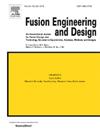Design and vibration test of first mirror mount assembly for ITER divertor VUV spectrometer
IF 1.9
3区 工程技术
Q1 NUCLEAR SCIENCE & TECHNOLOGY
引用次数: 0
Abstract
The divertor vacuum ultraviolet (VUV) spectrometer is a diagnostic system in the ITER tokamak, monitoring impurity content and behavior in the divertor region. The first mirror of the spectrometer, made of silicon carbide (SiC), is exposed to harsh environmental conditions, including high temperatures and significant inertial loads from electromagnetic disruption events. To ensure its reliable performance, we have designed and tested a robust mirror holder assembly. This paper introduces a novel design of the first mirror holder assembly for the ITER divertor VUV spectrometer and presents the results from comprehensive vibration tests conducted on a full-scale mock-up. The design features a double-holder structure with spring plate assemblies to accommodate thermal expansion and resist vibrational loads. The mock-up underwent a series of resonance search, sine dwell, and random vibration tests, replicating the expected loads during vertical displacement events in ITER. The mirror holder assembly and the dummy mirror successfully withstood the vibration tests without damage, validating the design for the ITER environment. The results demonstrate the robustness and reliability of the mirror holder assembly, ensuring the accurate and reliable operation of the divertor VUV spectrometer in ITER.
国际热核聚变实验堆分流器紫外分光计首个镜座组件的设计和振动测试
岔流器真空紫外线 (VUV) 光谱仪是热核实验堆托卡马克中的一个诊断系统,用于监测岔流器区域的杂质含量和行为。光谱仪的第一面镜子由碳化硅(SiC)制成,暴露在恶劣的环境条件下,包括高温和电磁干扰事件产生的巨大惯性负载。为确保其性能可靠,我们设计并测试了一种坚固耐用的镜架组件。本文介绍了用于热核实验堆转发器紫外分光计的首个镜架组件的新颖设计,并介绍了在全尺寸模型上进行的全面振动测试的结果。该设计采用带弹簧片组件的双支架结构,以适应热膨胀和抵抗振动载荷。该模型经历了一系列共振搜索、正弦驻留和随机振动测试,复制了热核实验堆垂直位移事件期间的预期载荷。镜架组件和假镜成功经受住了振动测试,没有损坏,验证了在热核实验堆环境下的设计。结果证明了镜架组件的坚固性和可靠性,确保了热核实验堆中分流器紫外分光计的准确可靠运行。
本文章由计算机程序翻译,如有差异,请以英文原文为准。
求助全文
约1分钟内获得全文
求助全文
来源期刊

Fusion Engineering and Design
工程技术-核科学技术
CiteScore
3.50
自引率
23.50%
发文量
275
审稿时长
3.8 months
期刊介绍:
The journal accepts papers about experiments (both plasma and technology), theory, models, methods, and designs in areas relating to technology, engineering, and applied science aspects of magnetic and inertial fusion energy. Specific areas of interest include: MFE and IFE design studies for experiments and reactors; fusion nuclear technologies and materials, including blankets and shields; analysis of reactor plasmas; plasma heating, fuelling, and vacuum systems; drivers, targets, and special technologies for IFE, controls and diagnostics; fuel cycle analysis and tritium reprocessing and handling; operations and remote maintenance of reactors; safety, decommissioning, and waste management; economic and environmental analysis of components and systems.
 求助内容:
求助内容: 应助结果提醒方式:
应助结果提醒方式:


